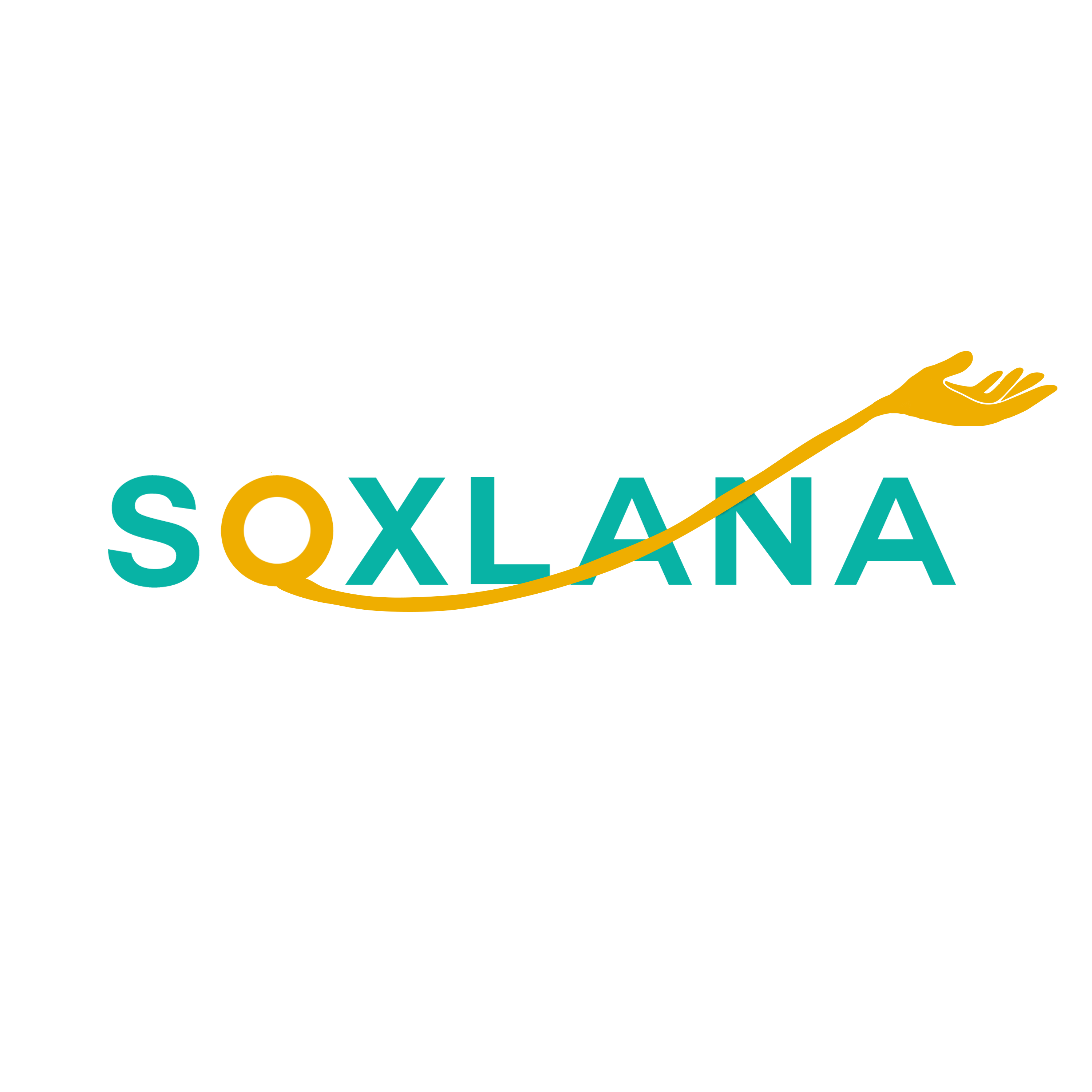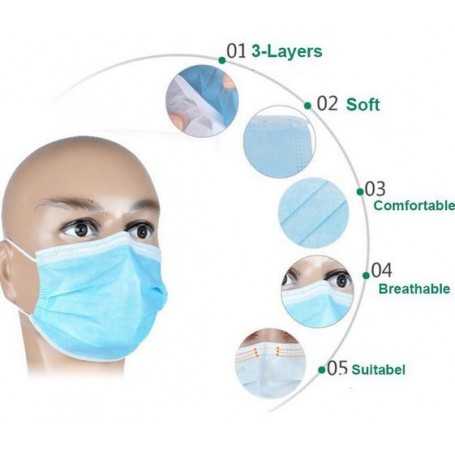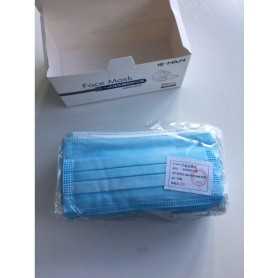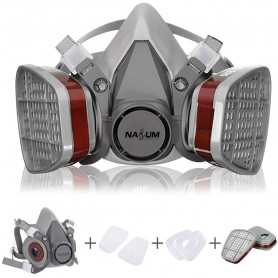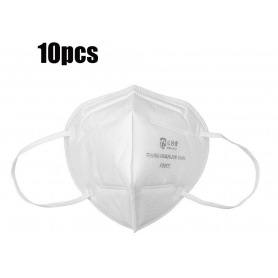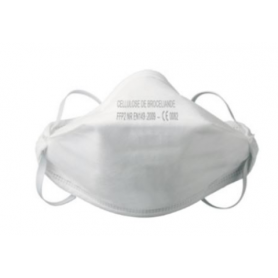FACE MASK - Disposable Protective Mask
FACE MASK - Disposable Protective Mask
Surgical mask
A surgical mask (also called hygiene mask or three-ply mask) is a single-use respiratory mask designed to limit the spread of germs (bacteria, viruses) to the environment very close to the mouth, nose and airways. of the person wearing it, retaining the respiratory droplets (postillions) in a non-woven filter screen comprising an impermeable layer. Thus microbial contamination of the immediate environment of the wearer of the mask is significantly restricted. However, the effectiveness of its action depends on its design, its manufacture, its adjustment and is greatly reduced after wearing for a few hours: it must then be thrown into an appropriate container.
One type of this mask is worn by healthcare professionals during surgery to protect the sterile operating field and prevent such infection of the patient there. For the same purpose, this mask should be worn by a contagious patient through the respiratory tract and it is sometimes worn by lactating women towards their infant.
Although it is not designed for this, and especially because it is relatively inexpensive, it is also often worn to protect on the one hand against air pollution and on the other hand against possible infections, such as during the Covid-19 pandemic in 2020: if it is well designed and adjusted, its effectiveness remains real, although somewhat imperfect. In open space (outside), staying far enough from any possible source of aerial contagion, the advantage of wearing a surgical mask is low. But it is not a respirator and cannot be certified as such
The other comparable masks are the protective masks known as FFP1 (medical) and the anti-dust masks (non-medical).
The global shortage of surgical masks is a central problem of the coronavirus pandemic in 2020.
Characteristics
Operation:
During a single use, a so-called surgical mask contains rather well the dispersion of the respiratory droplets produced during a sneeze (see the video opposite). However, this efficiency depends on its design, the materials used for its manufacture, its dimensions and its fit on the face. It has been shown that then it greatly limits the transmission of airborne viruses (influenza, coronavirus ...) by infected people.
Its effectiveness has also been demonstrated in confined spaces (inside buildings). For example, the widespread use (by patients, staff, visitors) of this type of mask in hospitals makes it possible to significantly reduce the risk of nosocomial flu5. In this context, it also shows an efficiency much higher than the tissue masks which can be used in case of shortage, as during the COVID-19 epidemic in 20207. The main reasons mentioned for the lower efficiency of the tissue masks being the moisture retention, low filtration capacity but also contamination when reused without washing with soap.
The protection provided during an inspiration is real but is not quantified for a surgical mask: It is not designed to protect the wearer against inhalation of bacteria or viral particles suspended in the air. This is why FFP protective masks offer better protection for this type of use.
For the effectiveness of the mask to remain, it must not be too wet, or even wet, because the filtering layer is then clogged. However, this occurs after prolonged wear (cumulative humidity of expiration), after intense and / or repeated sneezing, if sweat soaks (sports use), outdoors with rain.
Description:
Physical properties of surgical masks
Parameter Typical unit
Differential pressure, ∆P cm of H2O / cm²
Filtration efficiency%
Resistance to splashes of liquid mbar
Air permeability ml / s⋅cm² at 100 Pa
Water vapor permeability g / 24 hr⋅cm²
Waterproofing degree
A so-called surgical mask consists of 3 layers: 2 non-woven layers enclosing a filter layer. It can be of different shapes: folded (most often 3 longitudinal folds that can be deployed), duckbill (allowing a holding slightly distant from the lips), in a molded shell. It is held on the face either by lateral elastic bands passing behind the ears (ease of fitting but less tight fit to the face), or by straps to be tied behind the head (difficulty in fitting but good fit on the face) .
The presence of an internal nasal bar with the high and adjustable border greatly improves the quality of the fit to the face and therefore the effectiveness of the mask. In addition it reduces the formation of fogging on glasses.
The mask extends from below the chin to near the root of the nose, and laterally on the 2 cheeks. Sizes are possible (examples: man / woman / adolescent / child).
The so-called “care” masks are simplified surgical masks (type I), not very tight and inexpensive: they are preferred for the general public.
Good installation and disposal practices
The surgical mask must be very close to the face, covering the mouth and nose well. Wearing a thick beard does not allow a good fit. The retaining links must therefore be sufficiently tight; if they are elastic to be passed behind the ears, they can be shortened by a knot for young children, but pediatric masks, adapted to their morphology, are then recommended. To best ensure contact of the entire edge of the mask with the face, an integrated modular reinforcement (a metal tab) allows the top of the mask to be adjusted to the bridge of the nose. Many surgical masks have two sides: one white, containing the filter (therefore to be put in direct contact with the source of contamination: the wearer's mouth and nose), and the other colored, most often blue, does not containing no filter (therefore to be placed outside). The so-called 3-ply mask is placed with the pleats falling on the outside.
It must be removed by taking it by the links at the back, without touching the front (or the back) of the mask, then discarded (single use) in an appropriate closed container before another hand wash.
In the context of an epidemic, if the mask is used to protect against a contagion of infectious diseases, it will only be effective in combination with frequent and effective hand washing. The World Health Organization (WHO) recommends: wash your hands thoroughly before putting it on, do not touch the mask during use (or wash your hands immediately) and change your mask as soon as it is is wet. It should never be worn on the forehead, on the neck, on one ear or be put in the pocket, at the risk of contaminating the wearer in the event of repositioning.
The WHO stresses that, if it is misused by the general public, the mask poses more problems than it solves, and that, in all cases, barrier gestures remain essential.
Standardization - Regulation
Mandatory signage M016: Mandatory mask
Internationally, these medical devices are the subject of the ISO 13485 standard.
In the European Union, these masks are medical devices subject to:
European regulation 2017/745;
to standard EN 14683.
Compliance with these texts allows CE marking (indication generally carried only on the box of the mask pack).
These masks are of 4 types: according to their bacterial filtration efficiency (EFB), in the direction of expiration only: I (95% <EFB ≤ 98%) or II (EFB> 98%), and according to their resistance to splashes (if yes: R index, if no: no index); Examples: type I (intended for general use), type IIR (reserved for healthcare professionals working in operating theaters). These indications are generally worn only on the box of the mask pack.
At the French level, medical masks fall under the public health code.
The so-called surgical mask (except type R) is not personal protective equipment (PPE) since it is not designed to protect the person wearing it.
Uses
In contexts, countries or regions with low vaccination coverage by healthcare professionals or patients, or with variable efficacy of the vaccine, wearing a surgical mask is one of the means of preventing or reducing the spread of an epidemic.
In a professional medical environment
Despite their name, not all so-called surgical masks are suitable for use during surgical operations. They can be used as surgical, medical, dental or medical isolation masks.
For the general public
This so-called surgical mask is used in particular in major cities in East and Southeast Asia to limit the inhalation of air pollutants, or contamination by viruses such as those from the flu or coronaviruses.
Since the early 2000s, surgical masks have generally been worn by the general public all year round in East Asian countries such as China, Japan and South Korea to reduce the risk of spreading disease. airborne to others and to prevent inhalation of air pollution related particles. These surgical masks have become a fashion statement, especially in contemporary East Asian culture, further enhanced by its popularity in popular Japanese and Korean culture.
In times of air pollution
During an epidemic: acceptability and effectiveness
These masks are thus widely used in China, Hong Kong, Vietnam, or even in Toronto during SARS epidemics (severe acute respiratory syndrome) in 2002-2003, in Mexico City during the epidemic of influenza A (H1N1) in 2009 and in many countries during the 2019-2020 coronavirus disease pandemic. In the event of a shortage, they are above all recommended to nursing staff and people with symptoms (cough and fever).
Returns Policy
You may return most new, unopened items within 14 days of delivery for a full refund. We'll also pay the return shipping costs if the return is a result of our error (you received an incorrect or defective item, etc.).
You should expect to receive your refund within four weeks of giving your package to the return shipper, however, in many cases you will receive a refund more quickly. This time period includes the transit time for us to receive your return from the shipper (5 to 10 business days), the time it takes us to process your return once we receive it (3 to 5 business days), and the time it takes your bank to process our refund request (5 to 10 business days).
If you need to return an item, simply login to your account, view the order using the 'Complete Orders' link under the My Account menu and click the Return Item(s) button. We'll notify you via e-mail of your refund once we've received and processed the returned item.
Shipping
We can ship to virtually any address in the world. Note that there are restrictions on some products, and some products cannot be shipped to international destinations.
When you place an order, we will estimate shipping and delivery dates for you based on the availability of your items and the shipping options you choose. Depending on the shipping provider you choose, shipping date estimates may appear on the shipping quotes page.
Please also note that the shipping rates for many items we sell are weight-based. The weight of any such item can be found on its detail page. To reflect the policies of the shipping companies we use, all weights will be rounded up to the next full pound.
